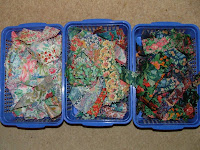LBQ
In light of the sadly lacking sewing experiences of school, it was hardly surprising that all my energies of youth were expended playing sport. On starting at the Grammar school we were put into competitive houses of Red, White or Blue. Following in the footsteps of my brother Ted and sister Gwyneth, I was put into Red House. Inter-house competition of every kind was encouraged and applauded and loyalties were established, built on the pride of simply belonging. Although I represented house and school in rounders and tennis as well, my particular love was hockey. I played right in the thick of it as centre forward; I played at lunchtime, after school and at weekends, for school, for local clubs and eventually for the county of Westmoreland. I suppose the pinnacle of my sporting career was reaching the ‘possibles’ versus the ‘probables’ for the England team! Although not accepted, it was gratifying to be considered.
MY QUILTING JOURNEY
MY QUILTING JOURNEY
This is a much better quilt for a young girl who loved her cats, with large shapes and bright colours. This quilt was tied with coloured embroidery threads so no time was spent on decorative quilting. Just the job!
Tam’s cat quilt
In 1984, we moved from Dorset where I had started to learn how to make quilts. My husband, Roger, worked as a civil servant, initially in the Ministry of Agriculture, Food and Fisheries (MAFF) and eventually in the Health and Safety Executive (HSE). His head office had de-centralised from London to Bootle, near Liverpool and he was advised that a stint there would be good for career development. ‘Just for a couple of years’ was his persuasive mantra as we tearfully left the village of Milton Abbas in rural Dorset for N Wales. 26 years later we are still living in N Wales and it was here that I became known eventually as ‘Dilys the Quilt’.
QUILTING 2010
QUILTING 2010
Tomorrow I go to Alston Hall, near Preston to spend a weekend with the Shoreline Quilters. This has been a most pleasurable annual event for the last 15 years, where I am amongst friends rather than students and where friendship and laughter are as important as technique!
Poppies 14” x 36”
Poppies: Detail














